Excavating the Hawaiian History of Kaua‘i’s ‘Russian’ Fort
A rich local history has long been overshadowed by a few months under a Russian flag.
Two centuries ago, King Kaumuali‘i was faced with an impossible decision: relinquish his island kingdom or doom his people to slaughter. With savvy diplomacy and a lot of careful maneuvering, Kaumuali‘i was able to avoid either fate. Adored by his people and respected by foreigners, Kaumuali‘i was, by all accounts, a king to rival all kings. But history has largely forgotten the man who would become the last ruler of Kaua‘i. Many children on Kaua‘i today only recognize his name because the island’s Highway 50 is named for him. But a local organization, Friends of King Kaumualiʻi, is determined to change that. Almost 200 years after his death, Kaumuali‘i has returned to Kaua‘i once more—this time as an eight-foot bronze statue overlooking the site of his royal compound and an adjacent star-shaped, basalt fort on the Hawaiian island.
“There was a lot of rain and lots of rainbows,” when the statue was finally installed, says Keao NeSmith, a descendant of Kaumualiʻi who posed for the statue. “It was spooky in a good sense. We believe that the elements of nature are blessings in Hawaiian culture,” and rain and rainbows are signs of aliʻi, Hawaiian royalty. Asked if he feels like Kaumuali‘i was there for the dedication, NeSmith is quick to respond: “Absolutely! We all felt it.”

There’s nothing left of Kaumualiʻi royal compound, but just 50 yards from the imposing bronze statue are the crumbling ruins of the fort he had presided over. Precarious piles of red volcanic rocks form the outer, star-shaped wall, and the remains of a few interior structures. If not for the informational panels at a nearby kiosk, it would be hard to tell what you’re looking at. Perhaps the most impressive part of the fort today is its location, at the mouth of the Waimea River, looking out toward the smaller islands of Niʻihau and Lehua. It’s immediately clear why a fort was built there.
But since the fort and surrounding grounds became a state park in 1972, there has long been a Kaumuali‘i-sized hole in the history told there. As tourists drive out to hike in 14-mile Waimea Canyon, they might just catch a confusing glimpse of a wooden sign with yellow lettering that reads, “Russian Fort Elisabeth: State Historical Park.” Confusion, it turns out, has swirled around the fort’s history since it was built in 1817. It has had many names: Pā‘ula‘ula, Fort Elizabeth, Old Russian Fort, and, finally, Russian Fort Elizabeth. Each tells a different piece of the history. Today park employees, scholars, Russian Americans, and the Kaua‘i community are all reassessing what those worn, yellow letters ought to read, and reckoning with the history that a name can simultaneously tell and erase.
When Kaumuali‘i became king of Kaua‘i and Niʻihau in 1794, he inherited a precarious situation. The Big Island’s ambitious ruler, Kamehameha I, had invaded Maui five years earlier, a conflict so bloody that bodies of the fallen dammed a stream. In 1795, Kamehameha invaded O‘ahu, where his forces drove 300 warriors off a 1,100-foot cliff to their deaths. As the only major island not under his control, Kaua‘i was clearly next.

In mid-1796, Kamehameha set sail for Kaua‘i with 1,500 canoes filled with 10,000 warriors, half of whom were armed with muskets. Kaumuali‘i, just 18, possibly with the help of his mother, Kamakahelei, were only able to muster a small force, 40 swivel guns, and three cannons. The invasion looked like it would be a disaster for Kaua‘i. But then “a big storm swamped all of [Kamehameha’s] boats trying to cross the channel,” says anthropologist and archaeologist Peter Mills of the University of Hawai‘i at Hilo, who wrote his dissertation on the fort and cowrote an article detailing much of this history. In 1803, Kamehameha tried again to invade Kaua‘i, only to have an illness descend on him and his warriors. To Kaumuali‘i, it seemed like “the gods were protecting the island of Kaua‘i,” says Mills. By 1805, Kamehameha began to consider diplomacy as a way to extend his dominion over the Kaua‘i.
In April 1810, a 32-year-old Kaumuali‘i, by then the sole ruler of Kaua‘i, finally met with Kamehameha to negotiate. While dodging assassination attempts from O‘ahu priest Kaumiumi and several coconspirators (an act not apparently sanctioned by Kamehameha), Kaumualiʻi agreed to a treaty that would see him continue to govern Kauaʻi as a vassal to Kamehameha until his death, after which control of the island would be transferred to Kamehameha’s descendants. “It wasn’t what he wanted, but he realized he was sort of being overpowered,” says Mills. Kaumuali‘i saw negotiation as a way to avoid a bloody conquest, but that didn’t mean that he intended to abide by the treaty.
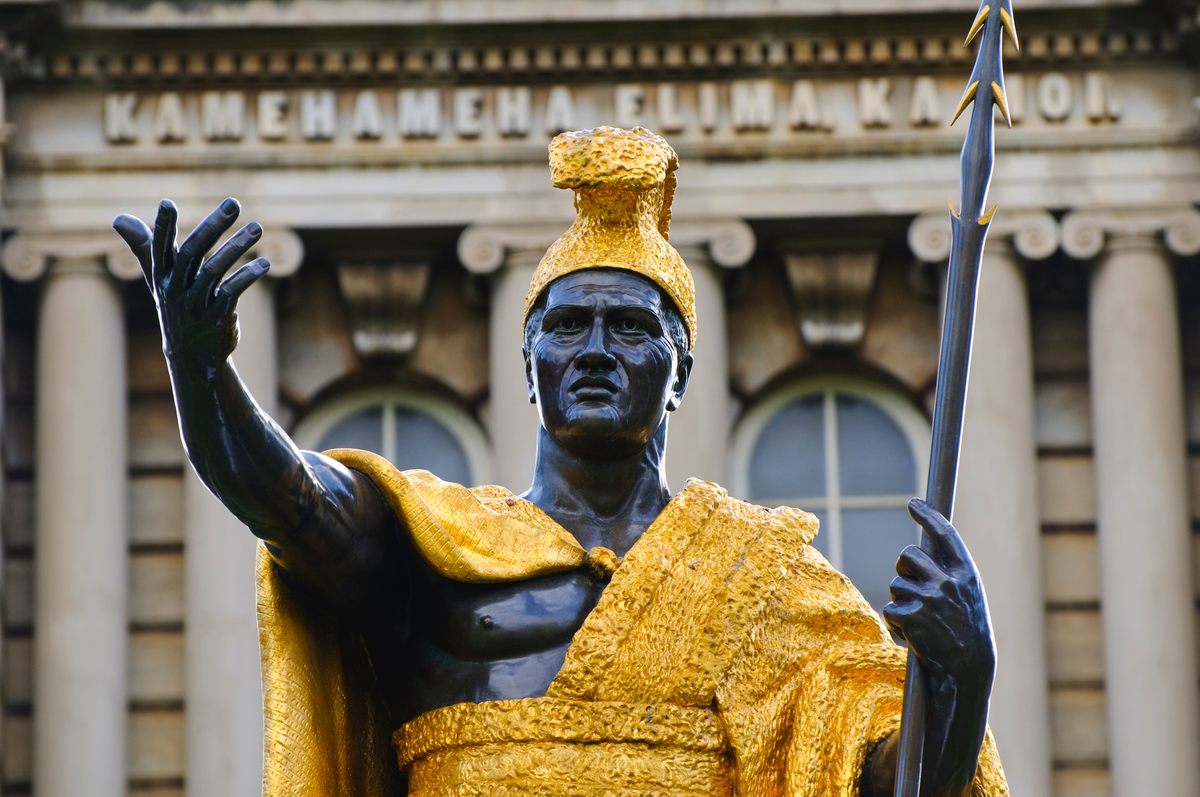
Two years after the treaty was signed, the War of 1812 erupted. Kaumuali‘i found a new ally: The Americans turned to Kaua‘i to hide from roving British warships. This emboldened Kaumuali‘i to stop sending tribute to Kamehameha and reassert Kaua‘i’s independence. But then the Americans left in 1814, exposing Kaumuali‘i to Kamehameha’s vengeance—until the Russians showed up.
In early 1815, the Russian American Company (RAC) trading vessel Bering shipwrecked on Kaumuali‘i’s doorstep. “He had just lost all the cannons and munitions that the Americans had had and now a storm picks up and basically pushes this vessel ashore, not anywhere on the island, but right outside his own residential compound,” says Mills, at the mouth of the Waimea River, the site of the yet-to-be-built fort. To Kaumuali‘i, the ship seemed another gift from the gods. He claimed all the weapons and cannons on board, while the surviving crew members eventually hitched a ride on another ship up to the RAC headquarters in Sitka, Alaska.
Then along came ambitious German surgeon and RAC agent Georg Anton Schäffer, sent by the company to befriend Kamehameha, secure trading rights, and negotiate the return of Bering’s cargo. Upon reaching O‘ahu in late 1815, Schäffer gained favor with Kamehameha after treating him and one of his wives for a severe illness. But soon he lost patience with the slow pace of trade negotiations and decided to head to Kaua‘i himself.
In summer 1816, he met with Kaumuali‘i, who says essentially, “Hey, welcome! If you want to help me to protect my kingdom from Kamehameha, I will sign over my kingdom to Russia,” according to Mills. This is where Schäffer’s eyes must have gone all bug-like. He immediately agreed to the proposal, and sent letters to the RAC and the Russian government in St. Petersburg announcing his diplomatic triumph.
![“I would love to sit down and talk to this guy for an hour, you know, just to talk to [Kaumuali‘i]," says anthropologist Peter Mills, here leading a tour of the fort.](https://img.atlasobscura.com/FZcGylcOJs-T8q5SOt-J1XpScnx9-mpU8lQBMC7WWm4/rt:fill/w:1200/el:1/q:81/sm:1/scp:1/ar:1/aHR0cHM6Ly9hdGxh/cy1kZXYuczMuYW1h/em9uYXdzLmNvbS91/cGxvYWRzL2Fzc2V0/cy82MDU5MDBmODk2/MzNiNjY4YjhfUGV0/ZXIgTWlsbHMgU3Bl/YWtpbmcgYXQgS2F1/YWkgRm9ydCBFbGl6/YWJldGggYXMgUGFy/dCBvZiAyMDE3IEZv/cnVtLmpwZw.jpg)
Kaumuali‘i gave the RAC land on Kaua‘i’s North Shore, which Schäffer eagerly renamed Schäfferthal, or Schäffer’s Valley. There, the RAC, with some help from locals, built Fort Alexander, named after Russian Emperor Alexander I, and the smaller Fort Barclay-de-Tolly.
Today, little remains of these installations. Fort Barclay-de-Tolly “was probably not much more than what a lot of people call a redoubt, which is just a small cannon emplacement with some fortification,” says Mills. At least the Russians had their priorities straight though; the redoubt was likely set up to defend, among other buildings, a distillery.
On the opposite side of the island, a largely Hawaiian workforce built another fort in Waimea—the fort “at the center of the recent brouhaha,” as Mills puts it. Unlike the wooden stockade structures of Fort Alexander, Fort Barclay-de-Tolly, and all other RAC installations from this period, this one was made of volcanic rock and earth, traditional Hawaiian building materials. Schäffer called the fort Elizavetinskaya krepost, or Fort Elizabeth, a nod to the emperor’s wife. Hawaiians, meanwhile, called it Pā‘ula‘ula, literally “red enclosure.” “Schäffer saw it as his fort [and] I’m convinced Kaumuali‘i saw it as his fort,” says Mills. And this is where the confusion began.
Because of the agreement with Kaumuali‘i, Schäffer considered all the Hawaiians building the Waimea fort Russian citizens, says architectural historian Alexander Molodin, who has studied the site extensively. “It is for this reason that Fort Elizabeth can justifiably have the name ‘Russian,’” he says.
Mills doesn’t think it should, believing that Kaumuali‘i built the fort as his own. “Schäffer was sort of picturing that he had control of the island in some sort of joint alliance and that he was somehow equally important as Kaumuali‘i. I know Kaumuali‘i didn’t view that relationship that way,” says Mills. If anything, Kaumuali‘i saw Schäffer as his subordinate, allowed to be on Kaua‘i only because of the king’s benevolence. Regardless of the confusion around the fort’s ownership, Kaumuali‘i’s hospitality was about to run out.
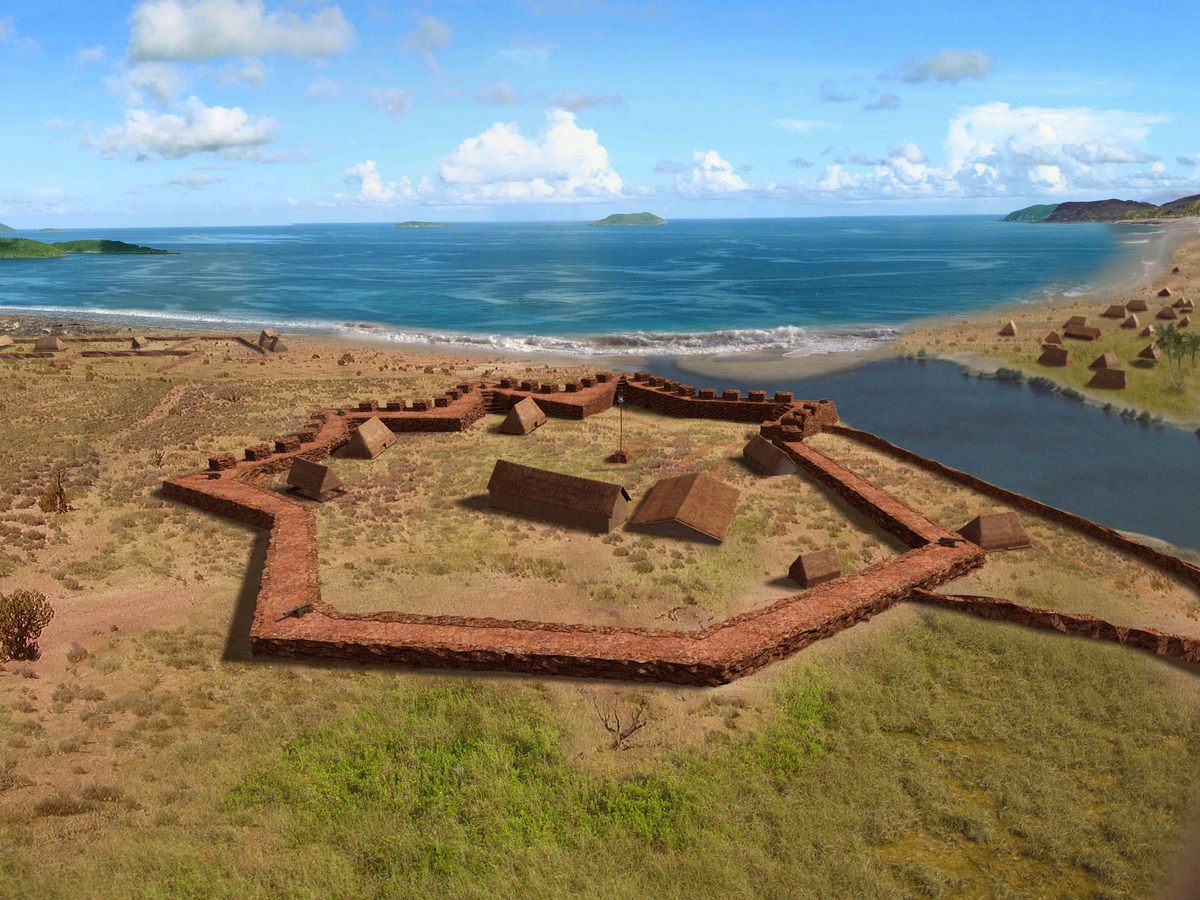
When the RAC and Russian government finally received Schäffer’s letters announcing his opportunistic territorial grab, they too went bug-eyed—but not for the reasons Schäffer had. Neither wanted anything to do with Kaua‘i or to get involved in the machinations of rival Hawaiian kingdoms, especially not while the United States secured a firmer toehold in the islands.
As one might expect, this revelation put quite the damper on Kaumuali‘i and Schäffer’s budding relationship. Mills imagines Kaumuali‘i went to Schäffer and said, “Look, you are more trouble than you’re worth. We’ve got to cut our losses and kick you off this island and try to work with diplomacy with Kamehameha again.” So on May 8, 1817, less than a year after Schäffer’s arrival, Kaumuali‘i, along with thousands of his people, ran Schäffer and his men off Kaua‘i. Schäffer’s escape boat, Kad‘iak, was leaking so badly that the crew ran it aground on O‘ahu. After several months of waiting, Schäffer was finally able to secure passage out on the American ship Panther, leaving behind 64 fellow RAC employees, who wouldn’t get off the island until 1818.
Kaumuali‘i would continue to rule Kaua‘i and its surrounding islands for the next seven years, until his death in 1824. He would see Kamehameha’s son, the impulsive Kamehameha II, take the throne in 1819. The younger Kamehameha even kidnapped Kaumuali‘i and coerced him into marrying his widowed mother, Kaʻahumanu, an episode missionary Hiram Bingham recounted in his 1855 A Residence of Twenty-One Years in the Sandwich Islands. “Whether Kaumuali‘i was regarded as a king or a captive,” writes Bingham, “it was not easy to decide.”
For more than four decades after the departure of the Russians, Kaumuali‘i and his descendants occupied the Waimea fort. “Hawaiians garrisoned the fort with their own troops, used it as an administrative center for Kaua‘i, and sometimes used it as a burial ground and a prison,” writes Mills in his article. Then, in the 1860s, it was abandoned and the buildings dismantled, leaving behind only the outer walls and a few foundations.
As the fort transitioned from an active Hawaiian military garrison to a historical site, its history started to morph. Russia’s involvement in the fort was highlighted while its Hawaiian history was largely forgotten or overwritten. Mills says this started happening as early as 1885, when surveyor George Jackson drew a rendering of the site “as it stood probably at the time the Doctor [Schäffer] was its commandant,” writes Mills. Since Schäffer hadn’t been at the site for almost 70 years, Jackson was taking what might be considered interpretive, Western-centric liberties. Though much of his characterization has been disproven by modern scholarship, the name on his rendering stuck: “Plan of Old Russian Fort, Waimea, Kaua‘i.”
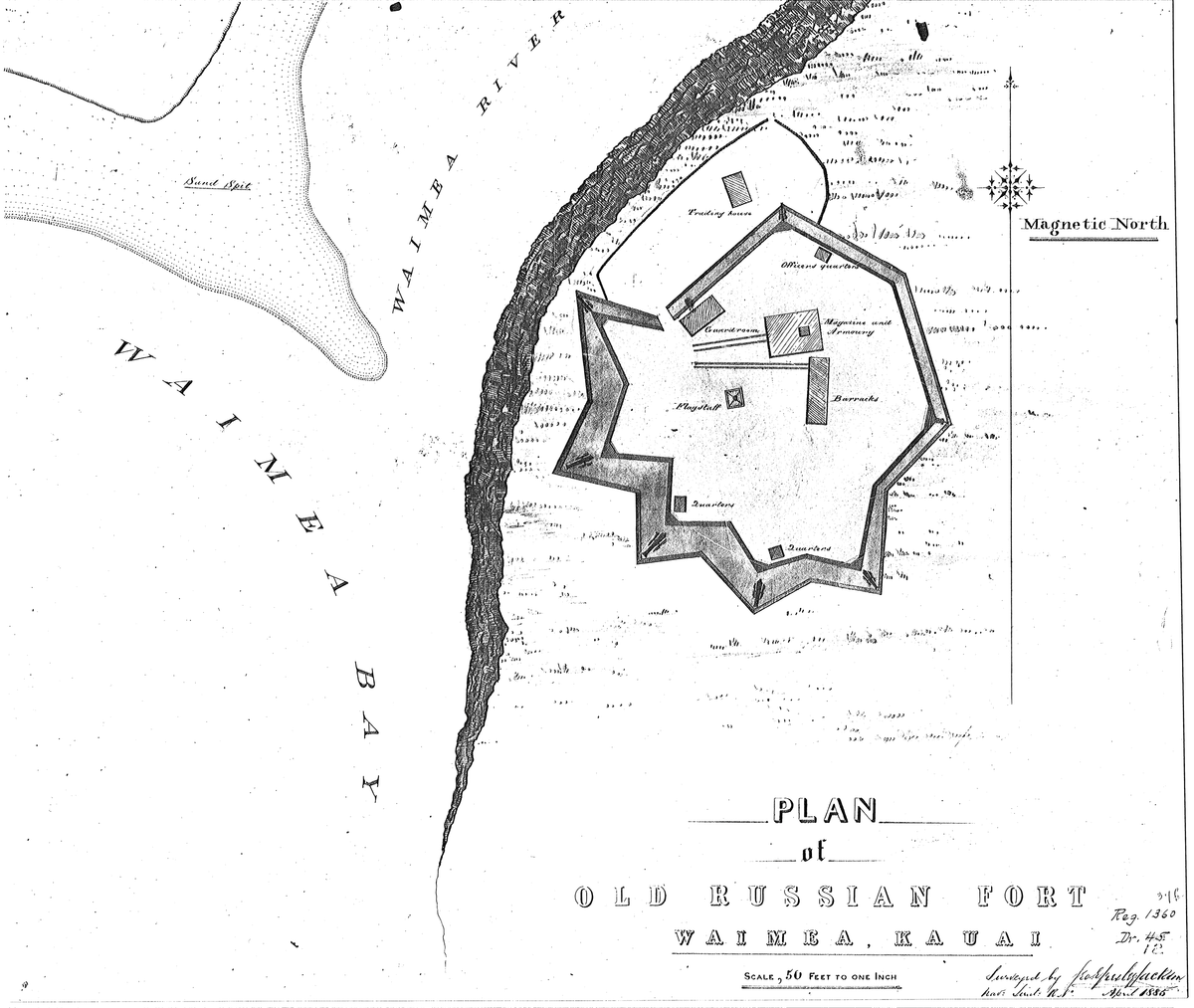
Almost a century later, the fort became a Hawai‘i state park with the name Russian Fort Elizabeth. Hawai‘i State Parks’ Martha Yent, who worked on the fort’s interpretive panels back in the 1980s, says the Jackson map “is probably a large part of where the name came from when we named [the park] Russian Fort Elizabeth.” Back then, Yent was working with the materials available, namely historian Richard Pierce’s 1976 book Russia’s Hawaiian Adventure, 1815–1817.
Both the panels and Pierce’s book foreground the Russian story on Kaua‘i, only mentioning King Kaumuali‘i offhandedly and completely omitting the fort’s Hawaiian name, Pā‘ula‘ula. The panels call the fort “Russian” and say it was “built under the direction of Georg Anton Schaeffer.” Kaumuali‘i’s rationale for the fort is never mentioned, and the signs only state that the Russians wanted it “to secure a provisioning station in Hawaii for the Russian-American ships.” After the interpretive panels were installed in 1987, the park was largely left alone, with only the occasional tourist stopping by, sometimes just to use the park’s public restroom.
In recent years, thanks to Molodin, Russian-Hawaiian Mihail Gilevich, and self-described “aging hippie” Jay Friedheim, there’s been renewed interest in the fort, especially from Russians and Russian Americans. For Gilevich and Friedheim, who work together in maritime law, it all started with a drunken bet. Friedheim, who has a knack for befriending “some extraordinarily cool people,” as he puts it, bet Gilevich he could meet Russian President Vladimir Putin. How? By rebuilding the Waimea fort, which he had recently visited. “Our vision was to try to figure out how to get it rebuilt like [California’s Fort Ross] so that it would be a really high-quality tourist destination,” says Friedheim. Together the pair traveled the world pitching the project, from San Francisco to Siberia, including a meeting with Russia’s Minister of Foreign Affairs, Sergey Lavrov.
At the same time, Molodin was organizing the 2017 “Fort Elizabeth Forum” commemorating the fort’s bicentennial. Yent, Mills, and Molodin were all featured speakers. Gilevich and Friedheim both attended, and Friedheim participated in a roundtable discussion about the “future of Russian-Hawaiian cultural heritage.”
The forum “was the impetus to creating a working group,” says Yent, “of about 12 to 15 individuals representing different organizations,” including Russian-American organizations, as well as representatives from Hawai‘i and the Waimea community. “As this working group got started,” says Yent, “I think everyone realized one of the first priorities needed to be updating these interpretive signs.”
As Hawai‘i State Parks’ interpretive program supervisor, “I was working with the group, coming up with some drafts,” says Yent. “People are on vacation in many cases so, you know, they are not there to read all of these paragraphs,” she adds, so the challenge becomes “condens[ing] it into an easy-to-understand brief history.” New temporary panels that highlight the Hawaiian contribution to the fort will be going up before the end of 2021, and more permanent signs will be installed in early 2023. These panels correct past mistakes with statements such as, “Kaumuali‘i directed the construction [of the fort].” The panels also talk about what happened after Kaumuali‘i drove the RAC out, and how he continued to build and improve the fort in the decades to come.

“It’s exciting,” says Yent, to see the culmination of four years of work and discussion come together in the new interpretative panels. “Along with the statue of King Kaumuali‘i, this is an important step in recognizing the long-standing ties of the Hawaiian people to this special place and the fact that it was a Hawaiian fort constructed by Hawaiian people and garrisoned by Hawaiian soldiers,” she says.
The question of what the fort and park should be named remains open. “You know, with the presence of the Russians not even spanning an entire year, that’s too little to be given the entire name,” says NeSmith. “You want to compare less than a year to how many centuries—seven, nine centuries—of our presence being there? We have earned that right to give the name the way we see fit.” For him, there’s only one option: Pā‘ula‘ula.
Many agree. “I very much feel that the name ‘Russian Fort’ has buried the Hawaiian history of that place,” says Mills. “If you’re a tourist and you see the highway sign ‘Russian Fort,’ you pull in expecting to see something that Russians built and Russians occupied. And neither of those things happened here.”
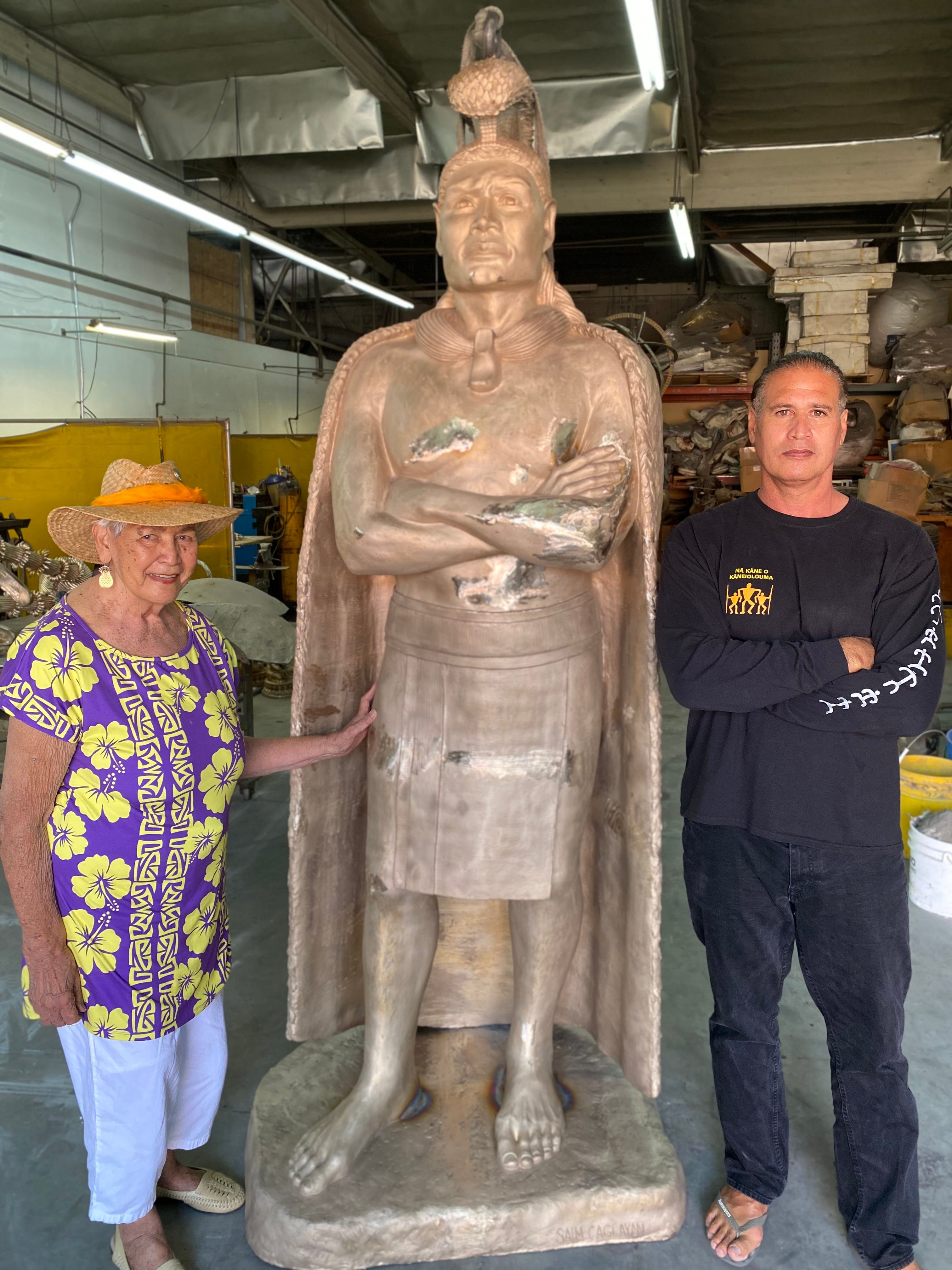
Molodin and Gilevich, on the other hand, would like to see the Russian presence at the fort remain in the name. “Taking into account the fact that the name ‘Pā‘ula‘ula’ appeared chronologically later than the name Fort Elizabeth, the name of the state historical park should reflect this peculiarity and be written only as Russian Fort Elizabeth / Pā‘ula‘ula,” writes Molodin. “We want to keep the original name so people will not get confused,” Gilevich agrees. “We are trying to find a compromise to preserve history on both sides.”
Ultimately the decision about what to call the site rests with Hawai‘i State Parks. Administrator Alan Carpenter says that the name change is going to happen. “Putting the traditional Hawaiian name first in a place that was Hawaiian both before and after the brief Russian stint there, it just has to happen,” says Carpenter, but he says there are still questions around what ought to follow Pā‘ula‘ula. “Will it be Pā‘ula‘ula / Fort Elizabeth? Will it be Pā‘ula‘ula / Russian Fort Elizabeth? Will it just be Pā‘ula‘ula? You know, there’s no willful intent here to erase any of the Russian story,” says Carpenter, “but only to have it be put in its proper context in a much greater story.”
For now at least, King Kaumuali‘i once again presides over his home, his people, and his story. “Having the King Kaumuali‘i statue up like that I think, for me, it helps to correct the very biased narrative of our own history,” says NeSmith. As a Hawaiian language scholar and educator, he knows plenty about how the Hawaiian story often is “glossed over” in schools.
He hopes the statue will begin to change that. “[The statue] gives us a reason to celebrate, to be happy knowing that our culture really was as rich and pervasive as it was. It was the only culture of the island at the time. And now that culture seems to be more of a behind-the-scenes sort of a thing. So there’s a big shift in paradigm that’s happening.”
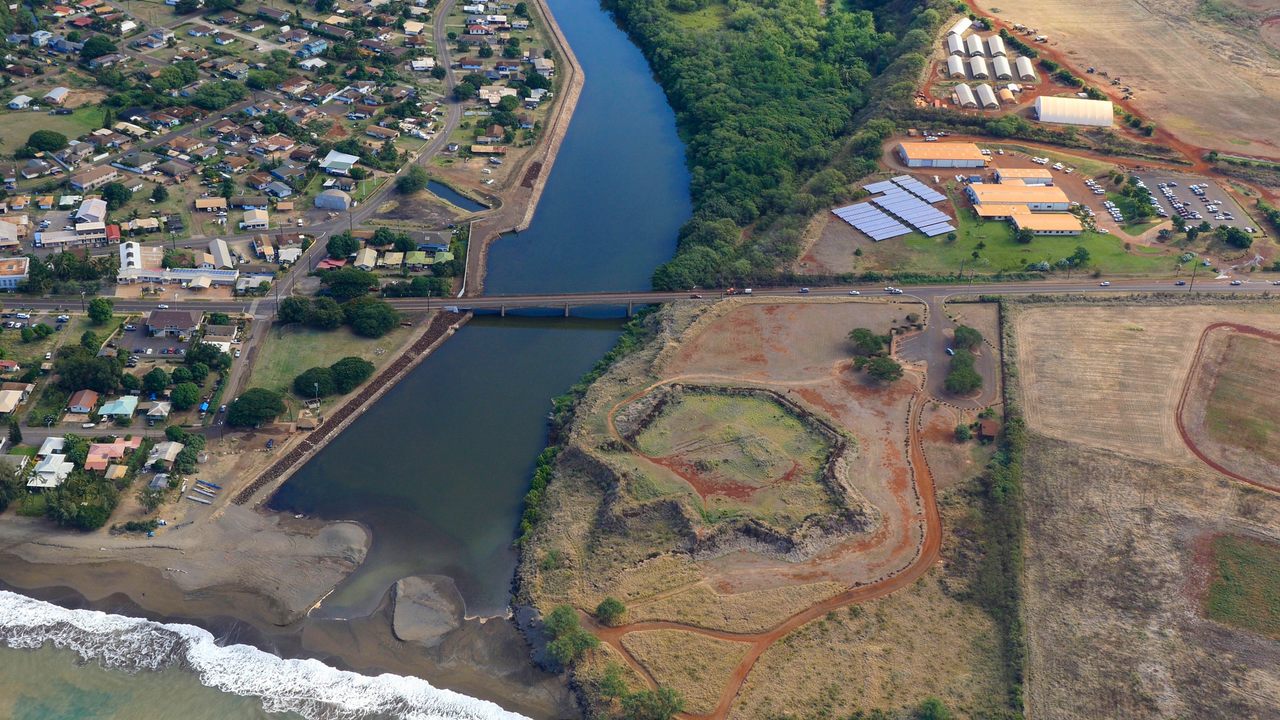
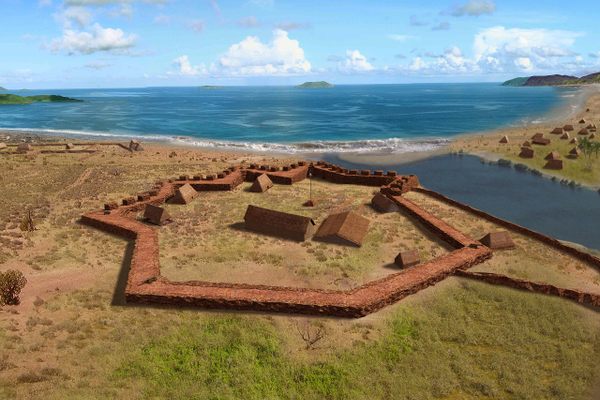



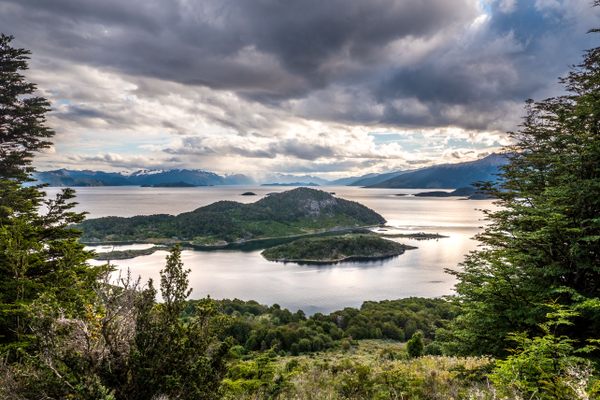

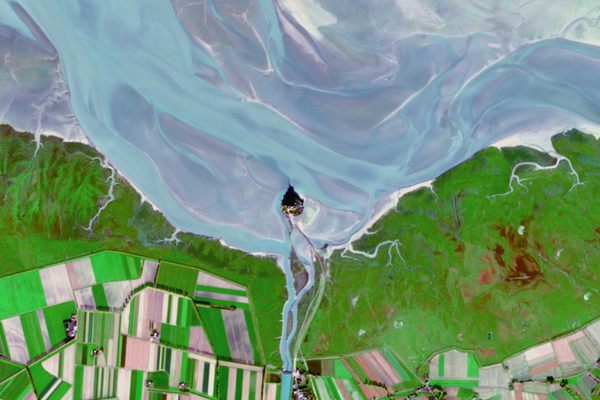






























Follow us on Twitter to get the latest on the world's hidden wonders.
Like us on Facebook to get the latest on the world's hidden wonders.
Follow us on Twitter Like us on Facebook